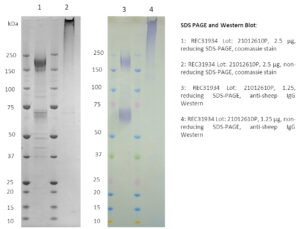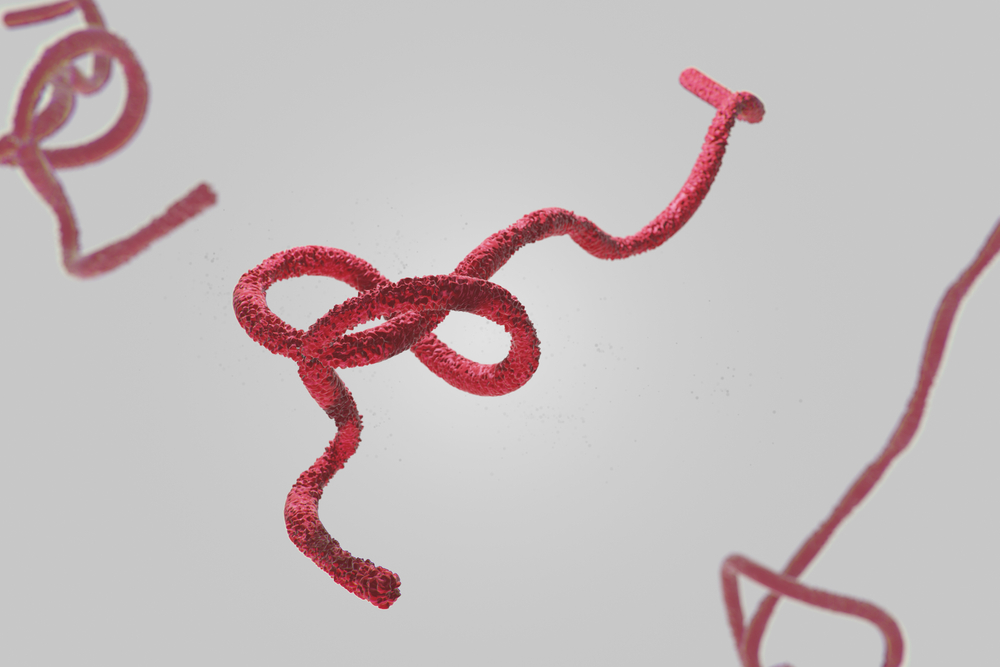
SDS-PAGE: Reducing and non-reducing SDS-PAGE, Coomassie-stained and anti-sheep IgG immunoblotted, showing purified Marburg Virus Envelope Glycoprotein (GP).
Marburg Virus Envelope Glycoprotein (GP), Sheep Fc-Tag (HEK293)
Price range: $824.00 through $3,129.96 excl. VAT
Marburg virus envelope glycoprotein (GP) is a recombinant MARV protein expressed and purified from mammalian cells.
MARBURG VIRUS ENVELOPE GLYCOPROTEIN (GP), SHEEP FC-TAG (HEK293)
Marburg virus envelope glycoprotein (GP) is a recombinant MARV protein expressed and purified from mammalian cells. The product contains both furin cleaved and uncleaved version of the protein.
PRODUCT DETAILS – MARBURG VIRUS ENVELOPE GLYCOPROTEIN (GP), SHEEP FC-TAG (HEK293)
- Marburg virus (Marburg virus/H.sapiens-tc/KEN/1980/Mt. Elgon-Musoke) envelope glycoprotein (GP) AA1-648 (Acc. No. YP_001531156.1)
- Expressed and purified from HEK293 cells.
- Contains furin-cleaved and uncleaved versions of the protein; 65-70kDa (furin cleaved) and 180-200 kDa (uncleaved)
- Presented in phosphate buffered saline.
BACKGROUND
Marburg virus (MARV) is a hemorrhagic fever virus of the Filoviridae family and a member of the species Marburg marburgvirus, genus Marburgvirus. MARV causes a form of viral hemorrhagic fever in humans and nonhuman primates and is considered to be extremely dangerous. The virus can be transmitted by exposure to Old World fruit bats or it can be transmitted between people via body fluids.
The GP gene is the fourth gene along the genome of every filovirus (Sanchez et al., 1993) and encodes a trans-membrane protein GP localized at the virus surface. Marburg virus contains only one transmembrane protein (GP) which is responsible for receptor recognition on target cells, and triggers viral attachment and entry. GP, a type I membrane protein of approximately 220 kDa, is acylated and highly glycosylated carrying N- and O-linked sugar side chains. GP is transported through the exocytotic pathway toward the plasma membrane where budding of virions takes place. In the trans-Golgi network, GP is proteolytically activated by the prohormone convertase furin into two subunits GP(1) and GP(2) (Sänger et al., 2002). The GP gene also codes for additional proteins, whose functions are not yet fully understood (Martin et al., 2016).
Viral cell entry is a critical point for infection, and as such, this step is targeted for the design of antiviral molecules. Antibodies have demonstrated that inhibitors targeting filovirus entry may provide a potent antiviral strategy (Martin et al., 2016).
REFERENCES
- Martin B, Hoenen T, Canard B, Decroly E. Filovirus proteins for antiviral drug discovery: A structure/function analysis of surface glycoproteins and virus entry. Antiviral Res. 2016 Nov;135:1-14.
- Sanchez A, Kiley MP, Holloway BP, Auperin DD. Sequence analysis of the Ebola virus genome: organization, genetic elements, and comparison with the genome of Marburg virus. Virus Res. 1993 Sep;29(3):215-40.
- Sänger C, Mühlberger E, Lötfering B, Klenk HD, Becker S. The Marburg virus surface protein GP is phosphorylated at its ectodomain. Virology. 2002 Mar;295(1):20-29.

